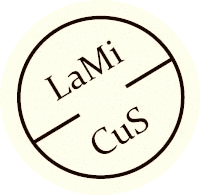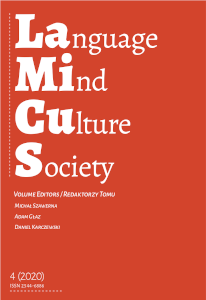Table of contents / Spis treści
Od Redakcji 8-11
Articles / Artykuły
Henryk Kardela, The linguistic sign from inside-out. Remarks on the formalist-functionalist debate: Noam Chomsky, Ronald Langacker and Daniel Dor 13-40
The paper examines three theoretical approaches to Ferdinand de Saussure’s linguistic sign represented by Noam Chomsky, Ronald Langacker and Daniel Dor. The choice of these authors is not accidental: using Frederick Newmeyer’s (1998) division of all linguistic theories into formalist (generative) and functionalist theories, one can claim, based on the examination of the relationship between the Saussurean signifier and the signified, that linguists of various linguistic persuasions exploit, in their actual linguistic practice, different areas of this relationship. Thus it seems, for instance, that the linguistic explanation in Noam Chomsky’s syntactocentric Standard Theory and the Government and Binding Theory should primarily be associated with the signifier-related area of the linguistic sign, whereas, because it concentrates on conceptualization and meaning-related aspects of the linguistic sign, Ronald Langacker’s model of Cognitive Grammar should be seen as “gravitating” toward the signified – rather than signifier-related – area of the sign. Then there is Daniel Dor’s (2016) linguistic theory. Because for Dor, language is a communication technology, where the linguistic sign provides an instruction for imagination and serves as a linguistic medium, so to speak, for closing the experiential gaps between language users, Dor’s theory, while firmly embracing the Saussurean concept of the sign, appears to go beyond the confines of the signifier-signified relationship. The question is: how far beyond? The answer we would like to give here is that, while these three theories are crucially based on the Saussurean conception of the linguistic sign, in order for them to be meaningfully compared and evaluated, we have to find a common theoretical ground for such an evaluation. Such a ground can be offered, it seems, by Merlin Donald’s (1991, 2001) External Symbolic System theory (ESS), which, we claim, is part of semiosphere, a symbolic network structure, initially introduced to culture studies by Yuri Lotman (1990, 2005).
Keywords: linguistic sign, Cognitive Grammar, Generative Grammar, language as communication technology, External Symbolic System theory, semiosphere
Barbara Lewandowska-Tomaszczyk,
A cognitive basis of contrary and counterfactual world-creating language 42-61
The present paper1 discusses a cognitive basis of English and Polish instances of counterfactuality in such phrases as oh, no, (not that again)/no nie, (znowu to samo), connected with contradiction, typically expressed in terms of positive versus negative sentences, as well as cases presenting contrary scenarios expressed as (a) dlaczego nie...? / (and) why not...?, which apart from the negative component involve alternative frames of events. It is argued that such phraseology introduces conceptualizations of events of a basically negative type which however activate a corresponding positive state of affairs (Lewandowska-Tomaszczyk 1996). Both similarities as well as differences between the two conceptualization types are presented and discussed and an argument is presented for the co-activation of the positive counterpart of the scene at the production of a corresponding negative sentence. It is argued in the present work for the possibility of the negative material incrementation to a relevant discourse domain in the analysed type of construction.
The language materials consulted are derived from the National Corpus of Polish (www.nkjp.pl) and the British National Corpus (BNC), translational corpora (paralela, http://pelcra.clarin-pl.eu/) and current monitor media corpora of Polish (monco.frazeo.pl) and English (monitorcorpus.
com), as well as relevant corpus tools generating concordances in full context, collocations and their frequencies (Pęzik 2018).
Keywords: (a) dlaczego nie S1, (and) why not S1, contrary (alternative) world, contradiction, counterfactual world (irrealis), diffused equivalence, English, negation, no nie (znowu (to samo)), no not again, Polish
Sami Chatti, Visual metaphtonymy in automobile femvertising 62-81 Retracted by the Author / Artykuł wycofany przez Autora
Maria Tsilimos, The English adversative coordinate structure with but: A Cognitive Grammar approach 82-121
According to Langacker (2012: 556), “coordination is a notoriously complex topic that poses serious descriptive and theoretical challenges.” Indeed, the packaging of information across elements or clauses of an adversative coordinate structure, which this study focuses on, unveils a spectrum of
cognitive mechanisms that are activated for the conceptualisation of a contrasting relation. Unfortunately, few studies have conducted a systematic analysis of English adversative coordinate structures from a purely cognitive perspective. This paper attempts to characterize, within the framework of Langacker’s (1987, 1991) Cognitive Grammar, the semantic structure of the English adversative coordinate structure with but. In particular, the characterization involves analysis of the semantic properties of the conjuncts joined by but, with the aim of observing the organisation of information across them. It is shown that, although the clauses joined by but express a complete meaning and can be syntactically independent in accordance with the premises of English grammar, they are semantically dependent on each other and, thus, one needs the other for the communication of a contrasting relationship between them. In other words, the two clauses constitute two parts of a whole, hence they are conceived as a single unit. Moreover, by illustrating the cognitive routes which speakers of English follow for the conception of the content of an adversative coordinate structure, the analysis reveals that there is an inherent asymmetry housed within it. Finally, this study argues that behind the visible contrasting relationship between the
two clauses joined by but, there are abstract, hidden relations across them which are inferred at the time of their simultaneous conceptualisation. The observation of the patterns of these schematic, invisible links will elucidate a range of cognitive capacities of the human mind to achieve high levels of conceptualisation.
Keywords: cognitive grammar, coordination, figure-ground, whole-part, asymmetry
Marta Dobrowolska-Pigoń, Middle voice and Polish verbs of emotion (paper in Polish) / Strona pośrednia a polskie czasowniki uczuć 122-151
The aim of this paper is to analyse the semantics of Polish emotion verb structures with regard to the presence of the clitic się. The Author analyses the Polish clitic się occurring in the so-called middle voice, which is in line with the concept of middle voice proposed by Suzanne Kemmer (1993), who positions this category between the prototypical transitive and intransitive events. The middle voice is contrasted with the reflexive voice. The difference between the middle and the reflexive voice Kemmer sees in the degree to which the participants of the event are distinguishable: while in the reflexive voice two participants of the relation can be distinguished, with the same entity filling both roles, the medium voice has a single, conceptually differentiated participant. The study also assumes that emotive events rely not only on experiential basis but also on culture models.
It is claimed in the paper that Polish emotion verbs with the marker się include those that have no causative counterpart lacking the middle marker (e.g. wstydzić się ‘be ashamed’) and those that have such an equivalent (smucić się ‘be sad’). The transformation of an intransitive construction into a transitive one with a causative verb leads to a significant change in the profiling of an emotive event. Moreover, in Polish the middle voice is available both for perfective verbs that profile reaching a state (such as przestraszyć się ‘ to take fright’) and for imperfective verbs profiling the state of experiencing an emotion (such as bać się ‘to fear’). The study has proved that (1) the Polish clitic się is a marker of the middle voice as defined by Kemmer; (2) perfective and imperfective verbs profile events that are differently positioned with regard to the prototype; (3) middle verbs allow the representation of an emotional state as an event with a certain degree of intentionality; (4) the extensive system of verbs with the clitic się is a reflection of the perception of emotional experiences that is entrenched in Slavic cultures..
Keywords: middle voice, verbs of emotion, intentionality, event, participant, Polish
Lucyna Bagińska, Conceptual blending in the study of the textual strategy inpoems about Arnold Böcklin’s paintings, on the basis of selected poems by Zofia Gordziałkowska (paper in Polish) / Amalgamat pojęciowy w badaniu strategii tekstualnej wierszy o obrazach Arnolda Böcklina na przykładzie wybranych utworów Zofii Gordziałkowskiej 152-181
The paper has three main aims. First, it describes how the theory of conceptual blending can be applied to explain complex processes in the writing of a poem that is inspired by a work of visual art. Second, it attempts to demonstrate that using the tools of this theory enables one to compare two ways of constructing a text about a painting in a way that is more explanatory and less intuitive than comparisons done so far in the theory of literature. Third, the conducted research is an attempt to solve a genological dilemma: Do differently constructed discourses about a painting belong to different genres or are they variants of the same genre? This dilemma has not yet been definitively resolved by literary theorists dealing with an intersemiotic translation (cf. Dziadek 2018; Słodczyk 2018). Słodczyk (2017) proposes that hypotyposis should be treated as a distinct literary genre and not as one textual variant of a genre, whereas Dziadek (2018) proposes that it is one variant of a genre. The research material consists of selected poems by Zofia Gordziałkowska (the poetess of the Young Poland movement), which were inspired by the paintings of the Swiss artist Arnold Böcklin at the turn of the twentieth century: “Calm Sea” and “Poetry and Painting Muses.” The theoretical foundations of the paper are the theory of conceptual integration and elements of the theory of images (Boehm 2014) and their perception (Barthes 1985 [1964]; Kövecses 2011 [2006]), as well as selected concepts from the theory of literature, including the definitions of ekphrasis and hypotyposis. The conceptual integration networks presented and discussed in this paper show the intra-textual structural relations of the analyzed poetic texts. The networks afford considerable insight into the emergence of poetic meaning, but they also provide grounds for a detailed comparison of textual structures characterizing two different ways of writing poems inspired by paintings.
Keywords: conceptual blending, textual strategy, intersemiotic translation , ekphrasis, hypotyposis
Debate / Debata
What can Cognitive Linguistics contribute to other cognitive sciences, and what can it gain from other disciplines?
Interviews / Wywiady
Henryk Kardela, Przed językoznawstwem kognitywnym jest przyszłość
Aleksander Szwedek, Te pytania to oceany, a ja jestem na nich łódeczką dziecka wydłubaną z kory
Reviews / Recenzje
Thora Tenbrink 2020: Cognitive Discourse Analysis: An Introduction. Cambridge: Cambridge University Press.
ISBN: 978-1-108-42266-6 (Hb)
Rafał Augustyn and Agnieszka Mierzwińska-Hajnos (eds.) 2018: New Insights into the Language and Cognition Interface. Newcastle
upon Tyne: Cambridge Scholars Publishing. ix, 243 pp. ISBN: 978-1-5275-1646-5 (Hb)
Susan Nacey, Aletta G. Dorst, Tina Krennmayr, and W. Gudrun Reijnierse (eds.) 2019: Metaphor Identification in Multiple Languages:
MIPVU around the world. (Converging Evidence in Language and Communication Research) Amsterdam/Philadelphia: John Benjamins Publishing Company. 330 pp. ISBN: 978-90-272-0472-1 (HB), 978-90-272-6175-5 (E-Book)
Dorothea Horst 2018: Meaning-making and Political Campaign Advertising. A Cognitive Linguistic and Film-analytical Perspective
on Audiovisual Figurativity. (Cinepoetics – English Edition 2.). Berlin/Boston: De Gruyter. ix + 246 pp. ISBN: 978-3-11-057447-0 (Hb); 978-3-11-057878-2 (pdf); 978-3-11-057793-8 (epub)
Adam Głaz (red.) 2019: Languages – Cultures – Worldviews: Focus on Translation. (Palgrave Studies in Translating and Interpreting)
Cham: Palgrave Macmillan. xiii + 440 s. ISBN: 978-3-030-28508-1; ISBN eBook: 978-3-030-28509-8 Reviewed by Aleksandra Niewiara

